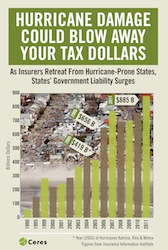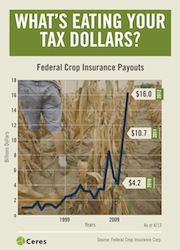With Earth Day a week away (Monday, April 22) there is a greater focus on climate change and the environment. According to Ceres, a nonprofit organization  mobilizing business leadership on climate change, a growing chunk of American tax dollars is footing the bill for increasing floods, fires, droughts and other climate-related changes. Ceres compiled data showing rising costs to three federal programs, as well as growing financial exposure for state taxpayers in hurricane-prone states.
mobilizing business leadership on climate change, a growing chunk of American tax dollars is footing the bill for increasing floods, fires, droughts and other climate-related changes. Ceres compiled data showing rising costs to three federal programs, as well as growing financial exposure for state taxpayers in hurricane-prone states.
“Climate change is fundamentally changing the United States, and American taxpayers are paying a huge price for it,” said Ceres President Mindy Lubber. “The cost of withered crops, submerged streets, hurricane damage and wildfires eventually comes out of our own wallets. Crop insurance losses from last year’s drought alone cost every person in America $51.”
The National Flood Insurance Program (NFIP) is staggering under massive losses after Hurricane Sandy, which triggered more than 115,000 new claims in just the first two weeks after the storm. Although NFIP collects about $3.5 billion a year in premiums, the amount of claims the agency has paid out has exceeded the amount of premiums collected in four of the past eight years. Last year’s losses in Sandy’s wake are expected to approach $8 billion.
“That’s $25 for every American, and that figure doesn’t even include the $50 billion of disaster relief that Congress approved in January for Sandy-impacted states,” Lubber said.
Taxpayers subsidize the Federal Crop Insurance program that was created during the 1930s Dust Bowl to protect farmers against crop losses. Federal crop insurance losses, due in part to the devastating, ongoing drought, have tripled in the past three years to $16 billion in payouts for 2012. “Last year’s crop insurance losses  amount to $51 a year for every man, woman and child in America,” Lubber said. “And this year will likely be costly too. The latest numbers from the U.S. Drought Monitor show more than 64 percent of the country is now experiencing some level of drought.”
amount to $51 a year for every man, woman and child in America,” Lubber said. “And this year will likely be costly too. The latest numbers from the U.S. Drought Monitor show more than 64 percent of the country is now experiencing some level of drought.”
In 2012, more than 9 million acres burned in wildfires — an area larger than the state of Maryland — making it the third-worst fire year in U.S. history. In 2012, the U.S. Forest Service overspent its available fire suppression budget by $400 million, as it has almost every year for the last 20 years, transferring millions of dollars away from other land management projects. And climate models show a likely increase in wildfires in coming years. “The costs are not just borne by the federal government,” said Lubber. “Wyoming and Montana spent more than $90 million of state money fighting wildfires in 2012.”
Ceres says that extreme weather, influenced by climate change, creates other taxpayer risks. State governments are increasingly liable for hurricane damages as private insurers pull out, leaving state taxpayers subsidizing insurance loss claims for homes and businesses.
“As Americans pay their taxes on April 15, they should also consider what their political leaders — in Washington and their state capitals — are doing to address climate change,” Lubber added. “Let’s hope, for our wallet’s sake, they’re tackling the issue head-on.”

